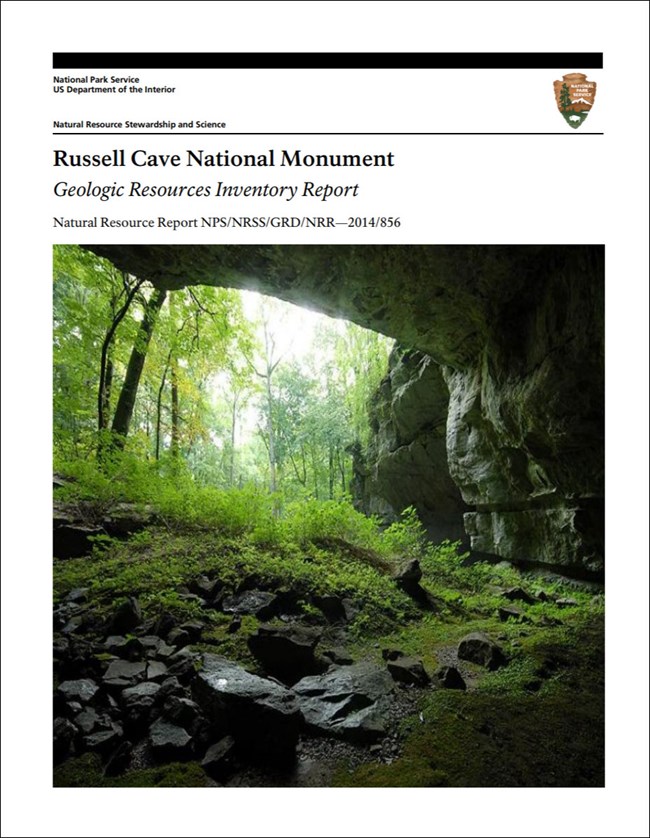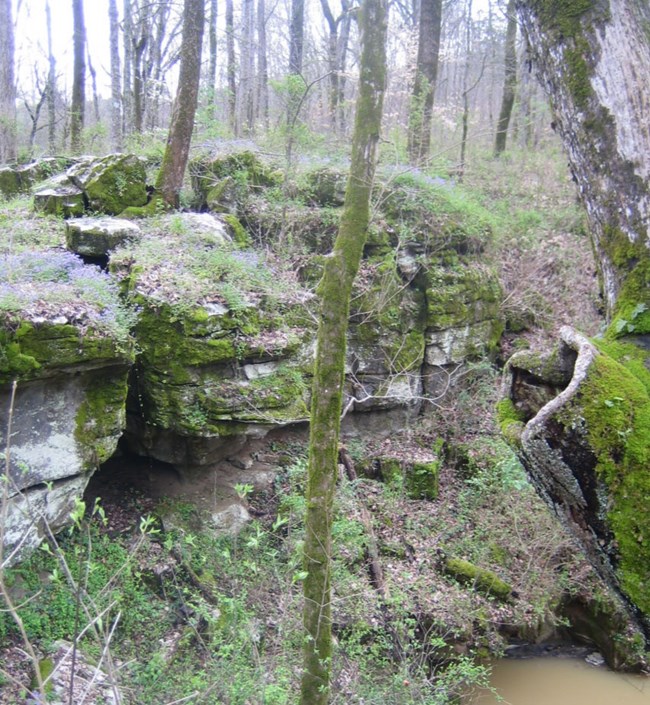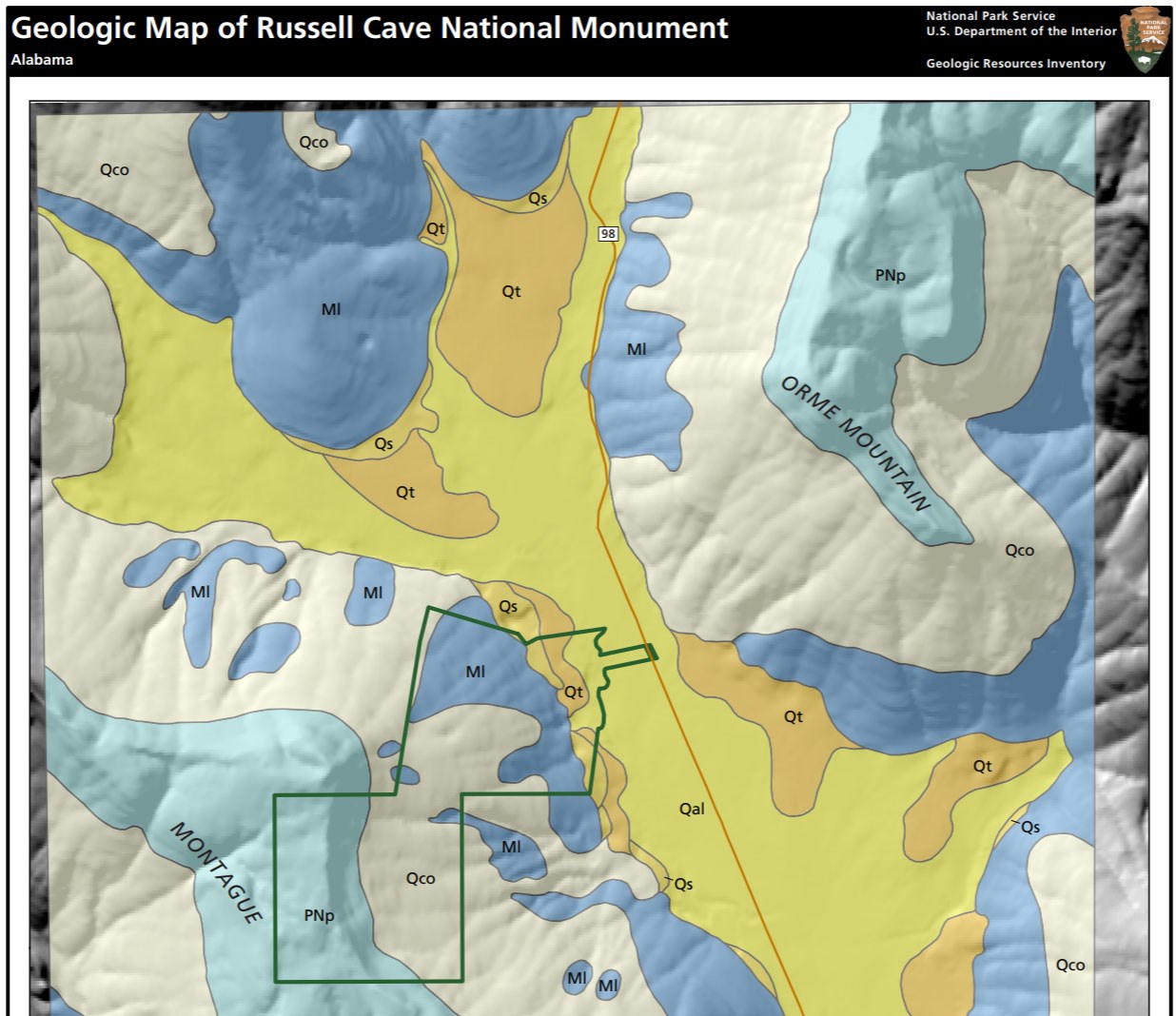Last updated: July 16, 2024
Article
NPS Geodiversity Atlas—Russell Cave National Monument, Alabama
Geodiversity refers to the full variety of natural geologic (rocks, minerals, sediments, fossils, landforms, and physical processes) and soil resources and processes that occur in the park. A product of the Geologic Resources Inventory, the NPS Geodiversity Atlas delivers information in support of education, Geoconservation, and integrated management of living (biotic) and non-living (abiotic) components of the ecosystem.

Introduction
Russell Cave National Monument (RUCA) is situated on the northeastern flank of Montague Mountain in Jackson County, northeastern Alabama. Proclaimed on May 11, 1961, RUCA contains approximately 125 hectares (310 acres) and preserves an almost continuous archeological record spanning nearly 10,000 years from at least 9000 B.C.E. to about 1650 C.E. (National Park Service 2016a). Russell Cave is a 929 m2 (10,000 ft2 ) cave shelter that contains a combination of geological features, hydrological processes, and natural resources that provided an optimum setting for human habitation for millennia. The monument contains a large number of sites related to the aboriginal use and occupation of the cave and preserves one of the oldest burials known to date in Alabama, with well-preserved material including some of the oldest bone tools, fishhooks, domesticated seeds, and weaving impressions in the Southeast (National Park Service 2014d).
Geologic Setting
Russell Cave National Monument is located on the Cumberland Plateau, a region comprised of Paleozoic-age sedimentary rocks with modest relief. The oldest bedrock mapped in RUCA consists of Mississippian-age shale and fossiliferous limestone of the Monteagle Limestone, Bangor Limestone, and Pennington Formation. Russell Cave developed in these ancient carbonate rocks after millions of years of dissolution and chemical erosion by percolating groundwater. Other karst features such as swallets, sinkholes, windows, and springs are associated with carbonate dissolution and are common in the monument area. Overlying the Mississippian strata is the Pennsylvanian Pottsville Formation, an erosion-resistant unit predominantly composed of coarse-grained conglomerate and sandstone with layers of coal (Thornberry-Ehrlich 2014). The Pottsville Formation forms ridges and caps Montague Mountain in southwestern RUCA. The youngest units in RUCA include Quaternary-age terrace and alluvial fan deposits, alluvium, and thin colluvium.
Regional Geology
Russell Cave National Monument is a part of the Appalachian Plateaus Physiographic Province and shares its geologic history and some characteristic geologic formations with a region that extends well beyond park boundaries.
- Scoping summaries are records of scoping meetings where NPS staff and local geologists determined the park’s geologic mapping plan and what content should be included in the report.
- Digital geologic maps include files for viewing in GIS software, a guide to using the data, and a document with ancillary map information. Newer products also include data viewable in Google Earth and online map services.
- Reports use the maps to discuss the park’s setting and significance, notable geologic features and processes, geologic resource management issues, and geologic history.
- Posters are a static view of the GIS data in PDF format. Newer posters include aerial imagery or shaded relief and other park information. They are also included with the reports.
- Projects list basic information about the program and all products available for a park.
Source: NPS DataStore Saved Search 3159. To search for additional information, visit the NPS DataStore.
A NPS Soil Resources Inventory project has been completed for Russell Cave National Monument and can be found on the NPS Data Store.
Source: NPS DataStore Saved Search 3110. To search for additional information, visit the NPS DataStore.

Related Links
Related Articles
Russell Cave National Monument
National Park Service Geodiversity Atlas
The servicewide Geodiversity Atlas provides information on geoheritage and geodiversity resources and values within the National Park System. This information supports science-based geoconservation and interpretation in the NPS, as well as STEM education in schools, museums, and field camps. The NPS Geologic Resources Division and many parks work with National and International geoconservation communities to ensure that NPS abiotic resources are managed using the highest standards and best practices available.

